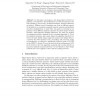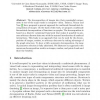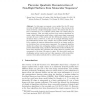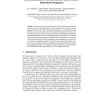ECCV
2010
Springer
13 years 11 months ago
2010
Springer
ECCV
2010
Springer
13 years 11 months ago
2010
Springer
Abstract. With the rapid development of fast data acquisition techniques, 3D scans that record the geometric and photometric information of deformable objects are routinely acquire...
ECCV
2010
Springer
13 years 11 months ago
2010
Springer
Abstract. This paper addresses the problem of registering a 3D model, represented as a cloud of points lying over a surface, to a set of 2D deforming image trajectories in the imag...
ECCV
2010
Springer
14 years 18 days ago
2010
Springer
Abstract. The decomposition of images into their meaningful components is one of the major tasks in computer vision. Tadmor, Nezzar and Vese [1] have proposed a general approach fo...
ECCV
2010
Springer
14 years 18 days ago
2010
Springer
The image of a planar mirror reflection (IPMR) can be interpreted as a virtual view of the scene, acquired by a camera with a pose symmetric to the pose of the real camera with res...
ECCV
2010
Springer
14 years 18 days ago
2010
Springer
In this paper we present a framework for semantic scene parsing and object recognition based on dense depth maps. Five viewindependent 3D features that vary with object class are e...
ECCV
2010
Springer
14 years 18 days ago
2010
Springer
Abstract. Domain adaptation is an important emerging topic in computer vision. In this paper, we present one of the first studies of domain shift in the context of object recogniti...
ECCV
2010
Springer
14 years 18 days ago
2010
Springer
Abstract. The sparse representation has been widely used in many areas and utilized for visual tracking. Tracking with sparse representation is formulated as searching for samples ...
ECCV
2010
Springer
14 years 18 days ago
2010
Springer
Abstract. In this paper we present a new method for the 3D reconstruction of highly deforming surfaces (for instance a flag waving in the wind) viewed by a single orthographic came...
ECCV
2010
Springer
14 years 18 days ago
2010
Springer
We present a novel variational method for the simultaneous estimation of dense scene flow and structure from stereo sequences. In contrast to existing approaches that rely on a ful...




